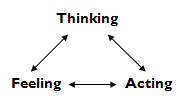In a recent post we looked at how mindfulness can help us let go of our thoughts when we get caught up in ruminating or worrying or just thinking in circles. Letting go of thoughts is never easy, however, and in this post we’ll look at how simply watching our thoughts can help us let them go.
Thoughts pop into our heads all the time, and usually we don’t pay any special attention to them: they enter and leave our minds all on their own, just like a car that drives into our line of sight, remains in our field of vision for a few moments, and then drives along and passes out of our line of sight again.
But certain thoughts tend to attract our attention. They grab us, suck us in, and we get stuck on them. Often it is thoughts that have a particularly strong emotional pull to them that we having trouble letting go of and allowing to just pass by on their own. It’s like our emotions are an adhesive that make thoughts related to a particularly strong emotion stick in our mind, where they stay stuck and don’t go away no matter how hard we try.
 For instance, if we’re feeling anxious, we’ll tend to get stuck on worrying thoughts; if we’re feeling sad, we’ll get stuck on thoughts of regret and disappointment; if we’re angry, we’ll get stuck on thoughts of having been treated unfairly or wronged. But if we can learn to just watch these thoughts despite their emotional pull, they don’t get stuck, and we can let them go as freely as any other thought that we don’t give a lot of attention to.
For instance, if we’re feeling anxious, we’ll tend to get stuck on worrying thoughts; if we’re feeling sad, we’ll get stuck on thoughts of regret and disappointment; if we’re angry, we’ll get stuck on thoughts of having been treated unfairly or wronged. But if we can learn to just watch these thoughts despite their emotional pull, they don’t get stuck, and we can let them go as freely as any other thought that we don’t give a lot of attention to.
The opposite of watching thoughts is to engage with them. We engage with thoughts by trying to understand them, respond to them, change them, judge them or react to them in any way. However, when we watch our thoughts, we simply notice that they are present in our mind, and just watch them as they come and go. We allow then to enter our minds and stay there for a while, and then let then go on their way.
As soon as we engage our thoughts, they tend to stick around, and lead to more thoughts, and before we know it we’re back to ruminating or dwelling or worrying. But if we can just let the thoughts come and go as they please, they tend to go away on their own, without us having to do anything special.
There are a number of metaphors that describe this process of watching our thoughts, including the ones below:
 Leaves Floating Down a Stream: Imagine a beautiful slow-moving stream. Once in a while, a big leaf drops into the stream and floats away down the river. Imagine you are sitting beside that stream on a warm, sunny day, watching the leaves float by. Now become conscious of your thoughts. Each time a thought pops into your head, imagine that it is written on one of those leaves.
Leaves Floating Down a Stream: Imagine a beautiful slow-moving stream. Once in a while, a big leaf drops into the stream and floats away down the river. Imagine you are sitting beside that stream on a warm, sunny day, watching the leaves float by. Now become conscious of your thoughts. Each time a thought pops into your head, imagine that it is written on one of those leaves.
The goal is to stay beside the stream and allow the leaves on the stream to keep flowing by. Don’t try to make the stream go faster or slower; don’t try to change what shows up on the leaves in any way. Just watch a thought come into your mind, write it on a leaf, and let the leaf float away downstream. (from Get Out of Your Mind and Into Your Life by Steven C. Hayes)
Thoughts Projected on a Screen: Meditation teacher Joseph Goldstein uses a metaphor of watching our thoughts projected on a screen. This is described in The Mindfulness and Acceptance Workbook for Social Anxiety and Shyness, by Jan Fleming and Nancy Kocovski:
It may help to imagine that you are sitting in a movie theater in front of a large blank screen. As thoughts, memories, and mental images appear in your mind, seeing them projected onto the screen, watching each thought for as long as it remains on the screen.
Thoughts may move slowly or quickly across the screen, some dominating the screen more than others. At times, the screen may go blank; at other times it may be completely filled with thoughts. Whatever is on the screen, remaining curious about the process of thinking itself, noticing your ability to be an impartial observer.
At times you may lose touch with your awareness of thinking, fusing with your thoughts, getting caught up in one of the stories unfolding on the screen. When that happens, returning to the feeling of the breath, not as a way to get away from thoughts or make the mind blank, but as a way to anchor yourself in the present moment, as you escort your mind back to its seat, returning to watching your thoughts coming and going.
The next time you find yourself caught up in your thoughts, unable to stop ruminating or worrying or going over the same thoughts over and over again, see if you can’t try to step back a bit and watch your thoughts. Instead of engaging them, just let them go, allowing them to pass out of your mind just like a cloud passing through the sky or a leaf floating down a stream.
Letting go of thoughts is often something we can’t do easily. The more stuck a thought or line of thinking gets in our head, the more difficult it becomes to let it go. In the next post, on cognitive defusion and letting go of thoughts, we look at some more ways to take a step back from your thoughts and get unstuck from them, and some additional strategies to help you watch your thoughts rather than engaging and getting caught up in them.





